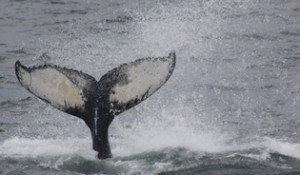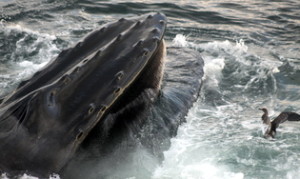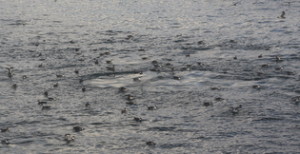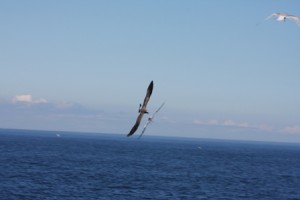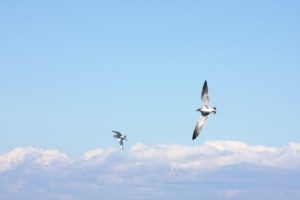Dolphin Fleet Naturalist Notebook – 21 August to 27 August
On August 21st we steamed towards the Southeast corner of Stellwagen Bank under a sultry late summer haze. Before an hour had elapsed on our morning trip we found ourselves amidst dozens of humpback whales, all of whom were feeding. Humpback whales spend at least half of the year in the feeding grounds bulking up on small schooling fish and krill, and when they find it, it is obvious! These 30-40 ton animals concentrate their prey by kicking, blowing bubbles, and then lunging through the massive schools of sand lance that have been stunned into submission from the force of the whale’s tail. Finally, they emerge with full mouths, draining the salt water between their flat baleen plates. One naturalist today recorded between 35 and 45 humpbacks all feeding within a 1-mile radius, just 8 miles north of Cape Cod!
As if this feeding frenzy wasn’t enough excitement for one day, one of the afternoon trips enjoyed a visit from Colt, a large male humpback famous for curious approaches to the boat.
On August 22nd the weather took a turn for the worse and we left the docks with our ponchos on prepared for gray skies and some drizzle. Our willingness to brave the weather was rewarded by a passing look at a basking shark on the way out of Cape Cod Bay. Basking sharks, despite their imposing appearance, have no teeth and pose no risk to humans; only to the near microscopic planktonic organisms on which they feed. Although they had stopped feeding at the surface, many humpbacks remained east of Stellwagen Bank.
Cajun and calf, surrounded by an ever-rotating group of humpbacks, have become some of our most ubiquitous humbpacks on Stellwagen this summer, and today they surfaced alongside Pele, Apex, Milkweed, and Jabiru. Like Cajun, Apex is a female, although she is quite a bit older, having been born in 1982. Cajun herself is only 12. Jabiru and Milkweed are relatively young themselves. Jabiru was first seen in 2002 and Milkweed was born in 2000. The oldest reported humpback was in its mid 90s, and scientists are still debating the average lifespan for humpbacks.
After three days of wind and high seas preventing the boats from leaving the harbor, we ventured out again on August 26th. In the morning, Wizard and Abrasion were seen feeding together by blowing bubble nets to corral their prey. They would surface simultaneously, trapping the fish behind the bristles on the inner edge of their baleen.
As the day went on, the sightings only got better until the mid-afternoon when over 40 humpback whales were documented. Ivory, Venom, Broomball, Tracer, Echo, Crystal, Bat, Strike, Dracula, Springboard, Eruption, Columbia, Bolide and Ventisca all made appearances to take advantage of the huge amount of fish in the area.
Although they feed on essentially the same prey items, fin whales and Minke whales tend to feed in a more subtle fashion. Today proved to be an exception as they too were seen aggressively lunging through schools of fish. Many passengers wondered why today of all days was such an exceptional day of feeding. Though there are many factors that influence food availability, it is possible that the churning seas over the last few days stirred up nutrients and altered prey distributions, resulting in an amazing day for whale watching!
Not to be ignored were the birds seen feeding with the whales. Indeed, large gatherings of birds are often seen among feeding whales as the large cetaceans drive fish up to the surface where the birds can take advantage of anything that the whales leave behind.
At one point, the naturalist implored passengers aboard the Dolphin VIII to look up to the skies for a moment to witness the drama going on overhead. A tern had caught a large sand lance and was being pursued by a parasitic jaeger. The parasitic jaeger, AKA the Arctic skua is known for its nasty tendency to harass smaller birds until they drop their food, allowing the jaeger to snatch it up. The tern put up a good fight, but eventually the jaeger prevailed and grabbed the fish as the tern dropped it from its beak. To our surprise, the tern fought back, and pursued the jaeger until they were both out of sight!
The feeding continued into August 27th and humpbacks both new and old feasted on the schools of fish inhabiting southern Stellwagen Bank. Whether they were feeding in pairs or on their own, these humpbacks never failed to awe the passengers aboard Dolphin Fleet boats as they came up with their mouths open, often lingering at the surface to actively push the saltwater from their mouths.
Salt, a whale that we’ve been watching return to Stellwagen yearly since 1976 blew huge rings of bubbles and emerged at the center of the ring with a mouthful of food. Salt can be distinguished by the bright white streak across her dorsal fin.
Salt was accompanied by her calf, Zelle, named for a high-quality white salt mined from peat which was popular during medieval times. As Salt searched for food, Zelle played at the surface, sometimes spyhopping to peer up at the boat, and once even breaching!
The feeding subsided as the day went on, but there were still plenty of humpbacks to be seen on every trip. We even spotted a small humpback less than half a mile off shore from Race Point! Despite the shortened whale watching week, the days that we had were some of the best of the summer!







